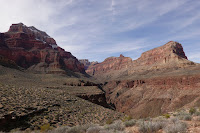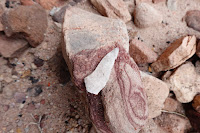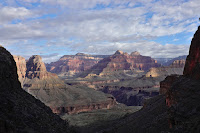Early in November 2023 Herman and I, together with a friend and colleague, Eduardo, did a four-day trip across the Escalante Route in Grand Canyon. It was Eduardo's first "real" backcountry trip, which was exciting. As we found out later, that wasn't the only reason the hike would turn out to be memorable. But we didn't know that at the time.
Day 0
Eduardo and I let our students out early and headed out from Tucson around 2 PM. The drive was uneventful except for some nasty traffic congestion while going through Phoenix. We reached Mather Campground around 8 PM. Herman had gotten to our campsite earlier that afternoon and sent us directions, which made finding the place easier. We didn't wait very long to set up our tents and crawl inside.
Day 1: Tanner Trailhead to Tanner Rapids
The night had been clear and cold: the temperature outside was 27°F (–3°C) when we rolled out of our tents at around 4:30 AM, the stars glittery and bright above us. We moved through the morning routine quickly and headed towards the trailhead at Lipan Point as the sky began lightening. The roads were deserted, the parking lots almost empty. We started down Tanner Trail around 7:30, just as the sun peeked over the horizon.
We had perfect hiking weather: not too warm, not too cold, and we made good time, though by the time we'd dropped below the Redwall layer our knees were feeling the effects of the steep and relentless descent. There were some familiar landmarks from previous trips down this trail: lunch, for example, was in the shade of a small overhang where, a few years earlier, Herman, Nancy, Tom, and I had taken shelter from the fierce sun. There were very few other hikers on the trail—I think we saw just a single party of five people heading downhill—and the silence and solitude made the hike even more enjoyable.
We reached Tanner Rapids around 1:30-ish. The afternoon was quiet and lazy: we sat around in the shade of a mesquite tree, relaxed, watched some kayakers go by below the rapids. It got dark around 6, I crawled into my tent around 6:30-ish, and fell asleep soon after to the roar of the rapids.
Day 2: Tanner Rapids to Escalante Canyon
The original plan for the day was to hike ten miles from Tanner Rapids to Seventyfive Mile Canyon. But we were tired from the hike down Tanner the previous day and ended up sleeping later than planned—I didn't come out of my tent until after 5! After a slow morning where we didn't push terribly hard to get going, we were on the trail by 7:30.
The hiking was very pleasant. We reached Cardenas Canyon, about three miles from Tanner Rapids, a little before 10. Just west of Cardenas Canyon the trail veers south and begins a gradual climb as it skirts some sheer high red cliffs overlooking the Colorado; across the river, on the opposite bank, is the big wide sweep of Unkar Delta. We took our time, stopping every so often to admire the landscape.
The hike to Escalante Canyon was more work than I remembered. Starting at an elevation of about 2,800' at Cardenas Creek, over the next 3-ish miles the trail climbs about a thousand feet to an elevation of about 3,800', with several tricky sections where we had to hike across boulder piles where the trail had been buried in rock slides. We were tired enough when we reached Escalante Canyon Beach that we decided to camp there overnight instead of pressing on to Seventyfive Mile Canyon.
While setting up camp I discovered that I had managed to lose one of the hoses I needed for my water filter. At first I thought (hoped) that maybe I had dropped it somewhere nearby while unpacking, but searching around didn't turn anything up. I was resigned to having to resort to my backup chemical water treatment when Herman figured out a way to use a component from his water system to address the problem. Yay Herman!
As we were eating dinner a helicopter suddenly flew upstream, flying very low—well below the Rim, so definitely not a commercial sightseeing flight—banked above us, and headed back downstream almost at river level! We thought it had to be a rescue flight, and considering how low it was flying we thought the rescue would likely be not too far away. We didn't see the chopper take off, so it must have flown down-river once it had completed the rescue.
As usual, I went to bed not long after dusk and fell asleep soon after crawling under my quilt. I woke up around 1:30 AM and went outside. Thin hazy clouds hid some of the stars overhead, but what I could see through gaps in the clouds still shone brightly. It was a beautiful sight.
Day 3: Escalante Canyon to Seventyfive Mile Canyon
This was the "rest day" of the hike. We all slept late—I didn't roll out of my tent until the unheard-of late hour of 6:30 AM, luxuriating in the laziness. After an unhurried morning routine we hit the trail around 8:30. Had we stayed with our original plan and hiked to Seventyfive Mile Canyon on Day 2, this would have been a lazy day of mellow day hiking up Seventyfive Mile Canyon. But we had chosen instead to camp a few miles away, at Escalante Canyon, so it turned instead into a short walk from Escalante Canyon to Seventyfive Mile Canyon with our backpacks on followed by a mellow day hike up Seventyfive Mile Canyon.
|
|
|
|

|
| Upper Seventyfive Mile Canyon |
Once we got to Seventyfive Mile Canyon we dropped our packs slightly up-canyon from the trail junction and day-hiked up the canyon. The canyon floor was mostly soft sand, and other than a couple of small scrambles the hiking was easy. A little way into the hike we came across a lovely surprise—a little trickle of water on the canyon floor and a couple of small water pools, with thickets of healthy-looking vegetation all around: a little oasis of green in the middle of rocky desert cliffs.
At first the trail up Seventyfive Mile Canyon generally meanders south-ish, but after about half a mile or so it takes a sharp turn and continues due east. A little while later the Desert Watchtower, far away on the South Rim, appears as a tiny little bump on the skyline. We hiked along until we got to a place that needed just enough of a scramble up a steep rock face that we decided to stop and turn around.
Seventyfive Mile Canyon has a strange split personality. The portion up-canyon from the trail junction is wide and shallow and bright with sunshine; by stark contrast, the lower canyon—from the trail junction all the way down to the Colorado river—is a dramatic slot canyon. As the canyon narrows into a dark passageway that winds along between towering vertical walls, the neat horizontal layering of rocks changes abruptly into a writhing twisted mess of fantastical shapes. It boggles the mind to imagine the forces that could have done this!
|
|
|
|
| Lower Seventyfive Mile Canyon |
The afternoon was quiet and pleasant. We found a cozy little camp area, right by the river that was sheltered by thick stands of vegetation, and sat around and relaxed. Dinner was early. Sunset was spectacular. Soon after it got dark we headed into our respective tents. As I lay in the darkness I could hear a loud chorus of either frogs or crickets singing their hearts out by the river, loud enough to drown out the roar of Nevill Rapids just downstream from our campsite. It seemed like a fun way to bring to a close a delightful trip.
Day 4: Seventyfive Mile Canyon to New Hance Trailhead
This turned out to be something of an epic day. But we had no inkling of that starting out.
We had a total of 8.5 miles to the Rim: two relatively straightforward miles from our campsite at Seventyfive Mile Canyon to Hance Rapids (albeit with two spots, Papago Wall and Papago Slide, which—although not really difficult—can be intimidating), then 6.5 miles on New Hance Trail, the first 1.5 miles of which are easy and flat followed by five very steep miles to the Rim.
We woke up early, around 4:30, and were on the trail by 6:30 AM. I had expected that, even hiking at the modest rate of 1 mph we would be out of the hike by 3 PM or so.
Unfortunately, it took us a lot longer to get through Papago Wall and Papago Slide than I had anticipated, and we didn't get to Hance Rapids until about 10:30 AM. It had taken us four hours to cover those two miles.
We were well behind schedule, with an important corollary that I didn't realize at the time: we were starting up New Hance Trail with correspondingly less water. My big worry at that point was running out of daylight before we got to the top and having to finish the (challenging!) upper sections of the trail in the dark, and it didn't even occur to me to refill our water at Hance Rapids—something that would have added yet another not-insignificant delay to the hike. So we hiked on with whatever water we had. In retrospect, this turned out to be a mistake.
Progress up New Hance Trail seemed to be going at a reasonable pace. We went off trail at one point but caught the error and recovered with little delay. But we slowed as the day wore on and the sun climbed high. We didn't reach the top of the Redwall Layer until about 2:30 PM; at that point we were averaging less than 1 mph. Lunch had not been a very large meal, and I was beginning to get tired. Somewhere around 3 PM I ran out of water. We were still over two miles from the trailhead and 2000 vertical feet below the Rim.
Between thirst and overall fatigue, I was moving quite slowly. After a while Herman volunteered to go up to the Rim, grab some water from Eduardo's car, and bring it down to us. With no better option, we split our group into two: Eduardo and I watched Herman head up the trail. Daylight gradually faded and it was pitch dark by about 6; we plodded on by the light of our headlamps.
Eventually I simply couldn't push on any further: I sat down to rest and promptly fell asleep. This break helped me recover sufficiently that after about twenty minutes we were able to resume our "one foot in front of the other" shuffle, but I think Eduardo was pretty spooked at that point (I don't blame him, I would have been spooked too).
Our thirst was pretty fierce—I could barely get any saliva in my mouth, and Eduardo's mouth was so dry that he could barely speak. Thankfully it was cool enough that, while deeply uncomfortable, the thirst was not incapacitating; with a rest stop every so often, we were able to keep trudging forward. By and large the trail was not too hard to follow, though there were several times where we lost the trail and had to rely on the GPS app on my phone to find it again.
The wind picked up as the evening wore on, and soon it was gusting so fiercely that it was throwing us off balance. The upper portion of New Hance Trail is steep and rocky and rugged enough that keeping one's balance and avoiding falls takes a lot of focus and effort even in daylight under normal hiking conditions; hiking as we were in our depleted state, on a steep rocky trail skirting deep dropoffs, and with everything around us pitch dark outside the little pool of light from our headlamps, and with fierce and unpredictable wind gusts trying to blow us off our feet, it was challenging indeed. The wind became ferocious enough that, in an attempt to offer a smaller cross-section, I began to drop down into a defensive crouch each time a gust hit. At one point we considered waiting until the wind slackened, but with no food and no idea how long that might take, this did not seem very promising. We kept moving.
All this time we had seen no sign of Herman. As the clock ticked on, our anticipation of Herman bearing jugs of water turned to worry over his absence, at the possibility that he might have fallen and injured himself trying to hurry back to us in the dark. At each bend and switchback on the trail I found myself checking for a human form slumped by the trailside. The last thing we needed at that point was another member of the team rendered hors de combat.
Gradually, the little dot that was us on my GPS app crept closer to the trailhead. It was past 10 PM now, and we had been without water for over six hours. Our thirst was excruciating, but we were so focused on reaching the Rim that physical discomfort seemed quite secondary. One foot in front of the other, then the trail flattened and the rocky cliffs gave way to a pine forest, and then we saw Eduardo's car in the distance with Herman's trekking poles lying nearby. We reached the trailhead around 10:30 PM.
Herman was parked at the trailhead in Eduardo's car, with several bottles of Gatorade that we quickly and gratefully guzzled. It turned out that once he reached the top (well after dark) he contacted GCNP Emergency Services, who declined to come find us since there was no medical emergency. He realized that he was too fatigued to try to go back down the trail, which was absolutely the correct decision given the circumstances. We messaged various folks back home, recovered Herman's car from the Lipan Point parking lot, and headed towards a hotel room in Flagstaff. The hike was done.





















































































